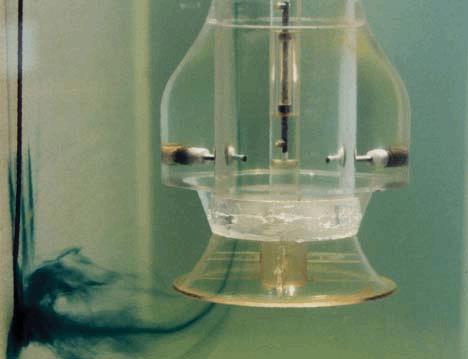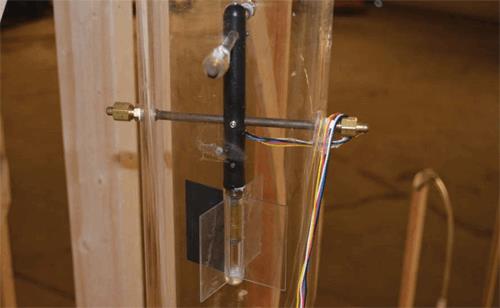Computational Fluid Dynamics vs. Physical Modeling For Pump Intake Design
By Dan Gessler, Andy Johansson, and Becca Hall
The past, present, and future of pump intake modeling is examined, highlighting the progress and value of computational fluid dynamics compared to tried-and-true methodology.
In today’s world of computational fluid dynamics (CFD), there are some applications where physical models remain as the only analysis tool that can provide reliable engineering design results. Pump intake design is one such area. The cost of physical models can be significantly higher than CFD; therefore, the temptation to use CFD is considerable. CFD can provide insight to the flow patterns approaching the intake, but is unable to consistently provide information about the vortex strength and temporal variation. For this reason, the Hydraulic Institute Standards (ANSI/HI 9.8-2012 and ANSI/HI 9.6.6-2009) do not recognize CFD as an acceptable means to predict flow patterns at the pump inlet or to show compliance with the acceptance criteria presented in the pump intake testing section of the standard.
The Hydraulic Institute (HI) was founded in 1917 and is a value-adding resource to member companies, engineering consulting firms, and pump users worldwide. The Hydraulic Institute develops and delivers comprehensive industry standards and tools for the effective application, testing, installation, operation, maintenance, and performance optimization of pumps and pumping systems.
The Hydraulic Institute Standard for Intake Design (ANSI/HI 9.8-2012) provides guidelines on when pump stations should be tested with a physical model and the model scaling requirements. Some of the criteria for pump stations that require physical model testing include individual pump flows or total station flow greater than 40,000 gpm and 100,000 gpm, respectively, intake or piping geometry that deviates from the standard, pump stations with nonsymmetrical or nonuniform approach flow, and/or pump stations where operation is critical or the cost of a prolonged outage for repairs is significant. For those pump stations that require testing, minimum model scales based on Reynolds number, Webber number, and absolute minimum model dimensions are given. The following paper provides information about the past, present, and future of pump intake modeling.

Figure 1. Vortex identification in a physical model
The Past
The performance of a pump can be negatively impacted by adverse flow conditions entering the pump. Adverse flow conditions including free and subsurface vortex formation, nonuniform velocity distribution, or preswirl can result in reduced pump efficiency, reduced pumping capacity, or vibrations that can damage the pump or require premature maintenance. Vortex formation has been studied by several investigators, including Alden staff members. An example of vortex identification in a physical model is included in Figure 1. These investigations led to the development of minimum model scale requirements that provide hydraulic similitude between the model and prototype. Standard testing methods were developed to measure the swirl and the velocity distribution approaching the pump impeller. A standardized system was also established to classify free and subsurface vortex activity. Acceptable preswirl, velocity distribution, and vortex activity were defined based on experience gained over many years comparing physical models and prototype operation. A physical model study conducted in accordance with the HI criteria by laboratories experienced with pump intake modeling should provide the same results, regardless of the organization.
About 15 years ago, Alden and others started experimenting with the use of CFD for pump intake modeling. CFD is unreliable at predicting the time-dependent unstable vortices that can be characteristic of pump intakes; however, the allure of a faster and more cost-effective modeling approach was significant. In the ensuing time, computers have become much more powerful, and CFD model codes and methods have improved, albeit at a slower pace.
Among civil engineering firms, Alden is one of the largest users of CFD in North America based on number of licenses in use. Alden also conducts 10 to 15 physical models of pump intakes each year, uniquely positioning Alden to conduct ongoing comparisons between CFD and physical model results. The research to date has failed to produce reliable CFD results for predicting pump intake performance.
The Present
In 2016, the HI invited leading CFD engineers from around the world to participate in a forum regarding the state of the art in CFD modeling of pump intakes. The modelers present all used a variety of CFD codes and turbulence models, including large eddy simulations (LES) run on massively parallel supercomputers. Alden discussed a one-year modeling effort that compared physical and CFD modeling results using three different commercially available CFD codes (Fluent, CCM+, and FLOW-3D) with simulations conducted by three CFD engineers. Agreement among the experts was unanimous: While CFD is considered a valuable and important tool for enhancing the value of physical model studies, it is still far from being able to replace physical models for pump intake modeling. CFD was unable to predict vortex strength in accordance with the existing HI criteria, and in some cases the direction of rotation was incorrect.
A significant shortcoming of using the current HI Standards when interpreting CFD model results is that the measurement techniques and acceptance criteria outlined in ANSI/HI 9.8- 2012 were developed specifically for physical models. The basis for acceptance is measurements that are readily made in a physical model, such as the swirl meter shown in Figure 2. A CFD model cannot report the number of swirl meter rotations because the swirl meter is not included in the model. Therefore, it is recognized that as CFD models improve, it may be necessary to develop standards specific to CFD modeling.
Additionally, CFD model results can be influenced by the individual modeler and the CFD code. For instance, different modelers will create different computational meshes, which in turn can affect results. To date there is no standardization for CFD modeling of pump intakes. When CFD is used to model a pump intake, it is important for the owner to realize that no accepted standards for the modeling exist.

Figure 2. Swirl meter instrumentation
The Future
An interesting topic for discussion is how the use of CFD in pump intake modeling will evolve in the coming years and decades. Crystal balls for predicting the future of CFD are hazy at best, but some information can be surmised with reasonable certainty. CFD models that use two-equation Reynolds Averaged Navier-Stokes (RANS) equation-based turbulence models are unlikely to be able to capture vortexing at pump intakes. The equations include simplifications that should preclude them from consistently predicting vortex formation. For example, the RANS equations assume that turbulent viscosity is isotropic (the same in all directions). While this assumption is valid for many situations, it does not apply to strong swirling flow, such as vortices, where turbulent viscosity is direction-dependent. LES models hold more promise, and while the models are too computationally intensive to be financially viable at this time, computers will continue to improve, and this limitation is expected to gradually diminish. In the near future, LES models will likely remain cumbersome to use and likely require vast amounts of output required to determine if a time-dependent vortex is forming. Despite these challenges, the use of CFD as a component of pump intake studies is expected to increase.
Extensive testing and comparisons between CFD results, physical models, and prototype performance are required to confirm that the CFD models can achieve a predictive reliability similar to that of physical models. The HI standards will need to be revised to include performance parameters that can be readily quantified in a CFD model. The original standards were based on many years of research, and it is reasonable that a similar amount of time may be required to develop and test standards written around CFD. Once the requirements for a reliable CFD model are established, it remains to be seen if a CFD model will be less expensive than a physical model.
Conclusion
While CFD is a useful and important tool in the pump intake designer’s toolbox, at present CFD modeling cannot be used to show compliance with the acceptance criteria presented in the testing section of the Hydraulic Institute Standards (ANSI/HI 9.8-2012 and ANSI/HI 9.6.6-2009). A major research effort will be required to conduct the necessary testing required to develop standardized methods for the use of CFD in pump intake modeling. For additional information about the HI Standards, please contact Peter Gaydon (director, technical affairs, Hydraulic Institute, pgaydon@pumps.org).
About The Author
 Dan Gessler, PE, Ph.D., DWRE, vice president of Alden Research Laboratories, has over 25 years of experience and is responsible for overseeing all of the hydraulic modeling completed at Alden. He provides technical expertise in numeric and physical modeling and also works on projects that combine large CFD and physical modeling efforts.
Dan Gessler, PE, Ph.D., DWRE, vice president of Alden Research Laboratories, has over 25 years of experience and is responsible for overseeing all of the hydraulic modeling completed at Alden. He provides technical expertise in numeric and physical modeling and also works on projects that combine large CFD and physical modeling efforts.
 Andy Johansson, director of hydraulic modeling, is responsible for all physical hydraulic model testing performed in Alden Research Laboratories’ Holden, MA, office. He provides technical and administrative supervision of Alden’s Holden Hydraulic Modeling Department to ensure high technical standards are maintained. Mr. Johansson has been with Alden for over 27 years.
Andy Johansson, director of hydraulic modeling, is responsible for all physical hydraulic model testing performed in Alden Research Laboratories’ Holden, MA, office. He provides technical and administrative supervision of Alden’s Holden Hydraulic Modeling Department to ensure high technical standards are maintained. Mr. Johansson has been with Alden for over 27 years.
 Becca Hall, engineer II, is a project manager at Alden who specializes in conducting physical model tests with an emphasis on pump intake modeling. She has over 10 years of experience in physical modeling of hydraulic structures.
Becca Hall, engineer II, is a project manager at Alden who specializes in conducting physical model tests with an emphasis on pump intake modeling. She has over 10 years of experience in physical modeling of hydraulic structures.
